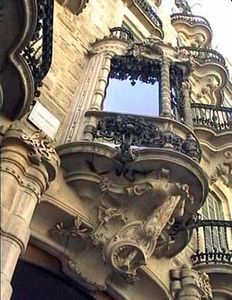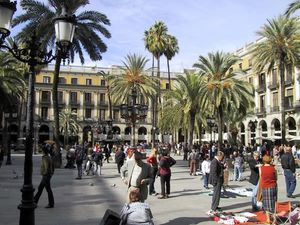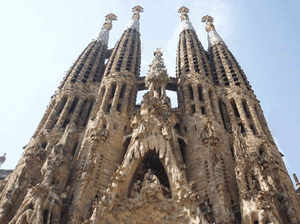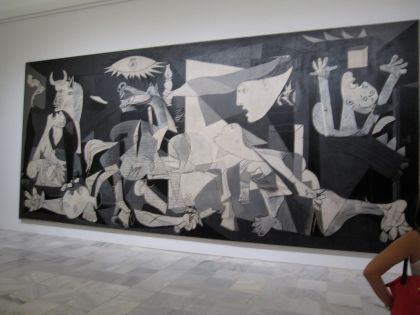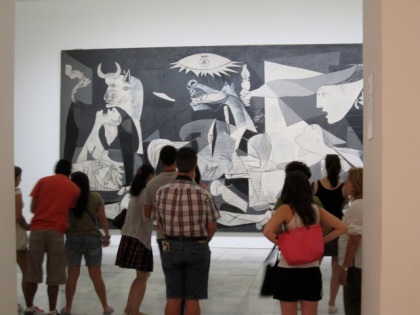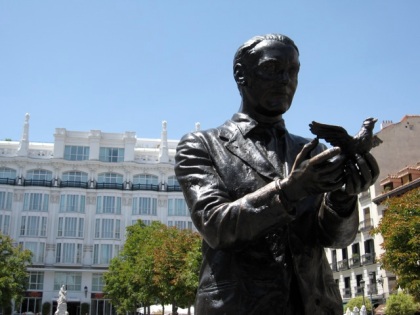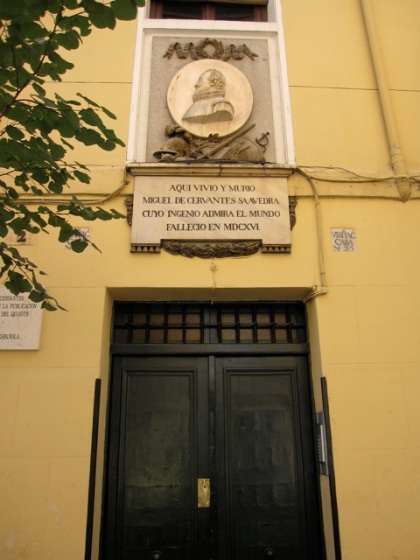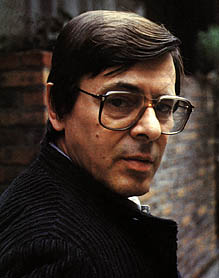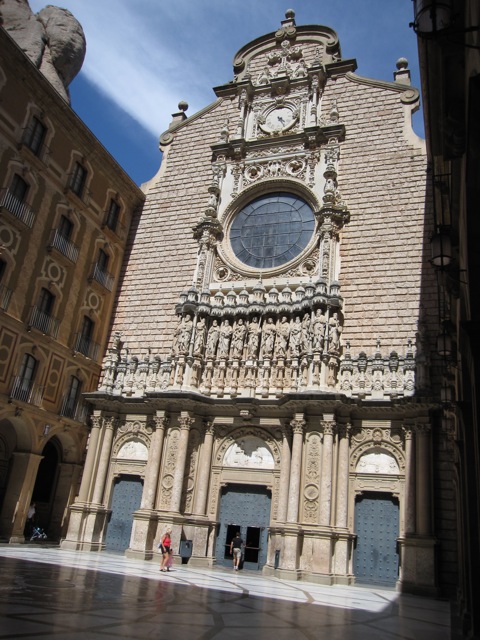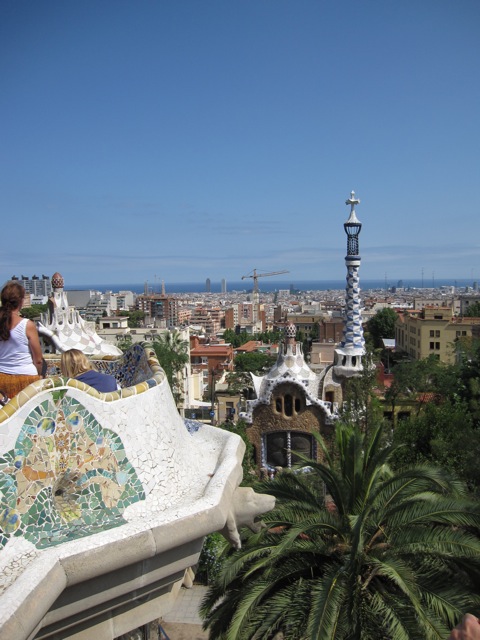NUNCA HAY TIEMPO SUFICIENTE
Lo siento, lectores fieles — I’ve still been traveling a lot, so not as much internet, but I have been filling my moleskins with notes, observations, and poems. I think, once I am settled, or maybe when I return to los Estados Unidos, I will retroactively update with the posts I’ve been writing in my head and notebook.
I just got back from Girona, Catalonia’s second or third largest city, though it feels infinitely smaller than Barcelona. It’s an ancient Roman/medieval town, and as soon as you enter the old city, it feels like you’ve been taken back in time. My new friend Anna (who is originally from Figueres, which is famous as Salvador Dali’s hometown) invited me to visit for a day, since she normally lives/works there. She showed me the city, and took me to see a comedic reinterpretation of Hamlet at Girona’s free summer theater festival…. and it was entirely in Catalan. If it sounds strange… well, let’s just say, it was interesting, but a delight to experience. The performance was very modern, and open-air, set against the backdrop of this beautiful, historic courtyard in Girona’s Culture Center.
I haven’t had time to upload my own Girona photos yet, but in the meantime, here’s a representative photo I borrowed online of Girona’s main waterway:
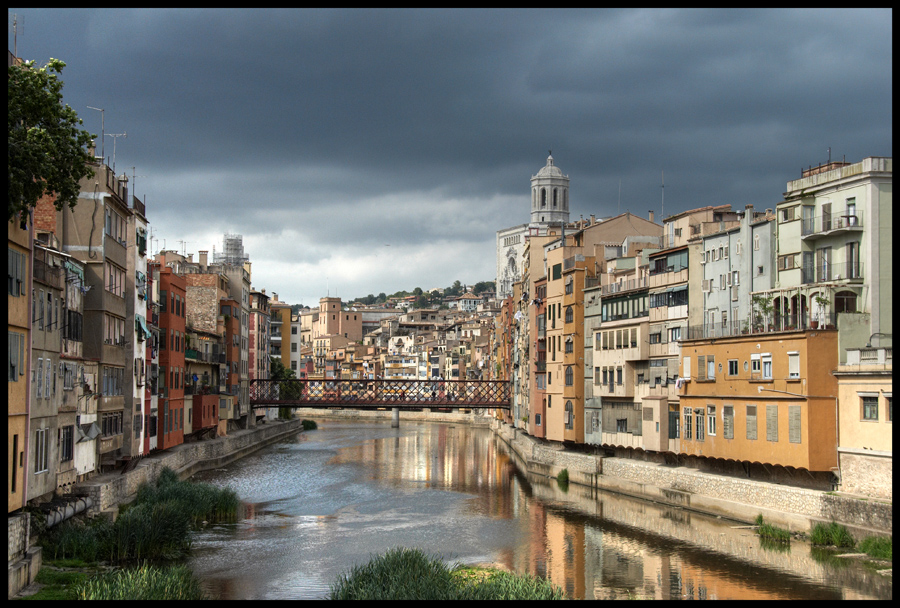
—
—
“AT LOUVRE, MANY STOP TO SNAP BUT FEW STAY TO FOCUS “
August 4, 2009, 1:09 pm
Yesterday I noticed a New York Times story that touched on something I mentioned in my last post — about how too often, museum-going is a rushed, quantity-over-quality affair. I’ve been mulling over the story since I read it, and in the meantime, it looks like it caught Masha’s attention as well!
Before I jump into my thoughts, here’s an excerpt from the beginning of the story:
“Spending an idle morning watching people look at art is hardly a scientific experiment, but it rekindles a perennial question: What exactly are we looking for when we roam as tourists around museums?”
And here’s another excerpt, later in the story:
“Cameras replaced sketching by the last century; convenience trumped engagement, the viewfinder afforded emotional distance and many people no longer felt the same urgency to look. It became possible to imagine that because a reproduction of an image was safely squirreled away in a camera or cell phone, or because it was eternally available on the Web, dawdling before an original was a waste of time, especially with so much ground to cover.”
Since so much of my summer has been devoted to “seeing art,” I think it’s valid to consider what exactly the goal of it is. Why is it worth it to see Guernica in person when you can just Google the photo, anyway?
Since I just wrote about Guernica in an essay about Valente, it seems an appropriate example to start with. Most people have seen—or at least know of—Picasso’s famous painting, and in the Reina Sofia, it was easily the star attraction. (From my photo of it in a previous post, you can see the tourists crowded around it.)
For starters, the sensation of seeing the painting in person is very different than simply viewing a reproduction or image. It’s gigantic, nearly covering an entire wall, and each of the separate images (such as the horse head or human body parts) becomes all the more startling. Because of its size and complexity, the painting is difficult to absorb as a whole—instead, the eye moves from figure to figure; the human or animal aspects, depicted in geometric style, blur with the indistinct shapes behind them. The NYTimes story talked about taking the time for “contemplation,” and this is a perfect example of a famous painting that demands your time and attention. The longer you view it, the more you notice new elements, and how those particular aspects interact to create the sensation and emotion of the larger painting.
Click photo!
For me, seeing the painting in person illuminated some of the ways Valente used it in his poem, “Guernica-Picasso-Guernica: 1973.” In the poem, Valente conflates the reality of death with the physical imagery of the painting: “el frío / horror que hizo nacer / en gris coagulado de Guernica” (the cold / horror that forced the birth / of Guernica’s coagulated gray). The poem, like the painting, is deliberately dehumanizing in the sense that it compresses the separate “agonía” (death struggle) of many people into “una sola agonía,” reflecting the anonymity of violence. (There is plenty more to say about Valente’s take on the painting, but I’ll leave it at that.)
The NYTimes story didn’t focus on this, but I also think going to a modern art museum like Museu d’Art Contemporani de Barcelona (MACBA)—as opposed to a more classical collection like the Lourve—has its own unique benefits and surprises. The MACBA, much like the MOMA in New York, has a permanent collection, but a majority of its galleries are dedicated to rotating or new exhibitions. In this way, wandering from room to room is a surprise. You never know who, or what, is coming next — and it allows you discover and be inspired by artists you had never before considered, or current artists who are experimenting with brand new styles.
I even had a similar experience in a museum filled with well-known classics, like El Prado in Madrid. When people think of Diego Velazquez, for instance, the first painting that jumps to mind is usually “Las Meninas.” But when I visited that particular painting, I discovered lesser known paintings by Velazquez that drew my intention even more — like “La Fragua de Vulcano.”
And then — and this will end my ramble! — there is the benefit of seeing a selection of art in the context of its time period. As I’m attempting to familiarize myself with modern Spanish art, for instance, I can learn more about a particular painting by Antoni Tapies, as an example, by seeing it placed adjacent to the work of his contemporaries like Antonio Saura and Manolo Millares, who shared a similar style. By doing so, it’s easier to notice aspects that the three painters share—as well as elements that may be unique to Tapies.

Ok, enough ranting from me. Back to translating. And next time I promise to include more photos.
—
ONE MONTH AND A VISIT TO MADRID
I’ve been here about a month now, and I feel settled and have my regular spots that I’ve started going to do work or read. There’s a cafe down the street that has become my go-to place to write during the day. No modern flair here— unadorned plaster walls, sturdy old tables, and strong espresso. And it’s always packed with people coming and going, sipping coffee, chatting with passers-by, or doing their own work. The ceilings are high, the tables well-worn, and in typical European fashion, it’s usually a little hazy with cigarette smoke.
Another spot I like to visit is called the “Cascada” (waterfall) in Parc de la Ciutadella, Barcelona’s largest park. It’s an elaborate fountain made to look organic (except for the huge stone dragons spitting water). It’s surrounded by sand pathways, and a little out-door cafe is a couple hundred feet away. When it’s not scorchingly hot outside, it’s a nice place to visit.
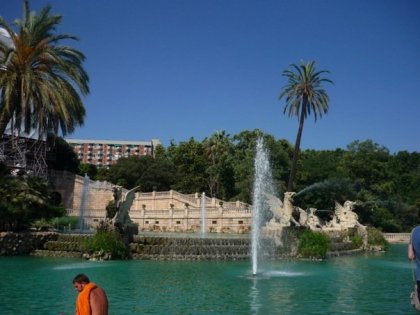
Having time is good for seeing art, too. The best way to see an art museum is to do so without being rushed to absorb a hundred paintings at once. I appreciated this more when I was in Madrid last week. I only set aside a few days to visit, and there is a LOT of great art in Madrid — so I had to cram a lot into a short amount of time. I made a list of works I knew Valente had written about, like Guernica, and made sure to visit them all.
Click photo!
Besides art, a friend of mine (who is finishing up the Fulbright in Madrid) showed me around the city. He took me around to some of the neighborhoods that he felt were particularly Madrileño, and we also explored the city’s rich literary history. We saw the statue of Lorca—one of my favorite Spanish poets—and the house where Cervantes lived.
Click Photo!
Click photo!
The bus ride to Madrid is 7 hours, which isn’t quick, but it was actually nice to drive through the rural areas and Spanish landscape that is mostly untouched by people.
—
MORE ON VALENTE
Click Photo!
Following Dan’s lead on his blog, I thought it would make sense to say a bit more about the poet I’ve been studying and translating since the Spring and while I’ve been here.
José Ángel Valente was a Spanish poet, essayist, and translator born in 1929 in Ourense, Spain. He died in 2000 in Geneva. Though he’s been translated very infrequently into English, many Spanish critics have called him the greatest of the post-Civil War poets.
Valente was very prolific during his lifetime, writing and translating dozens of books, but he is most known for his distinctive style and strong beliefs on language and poetry. As his career progressed, his poems became less representational and more abstract, through Valente’s belief that poetry should be about pushing language “to its limits.”
I was first drawn to Valente because of his passion for painting and sculpture, after studying visual art/poetry in a seminar with Bonnie Costello (at BU). Valente was active in the Spanish art scene, becoming close friends with major Spanish artists like Eduardo Chillida or Antoni Tapies; he often included their work and other’s in his poems and essays.
I just finished writing an essay on Valente’s book “Interior con Figuras” (Interior with Figures), one of his first books to deal extensively with visual art. Picasso’s famous “Guernica” is one of the paintings included in the book, and I was fortunate enough to see it on my short trip to Madrid last week (more on that soon!)
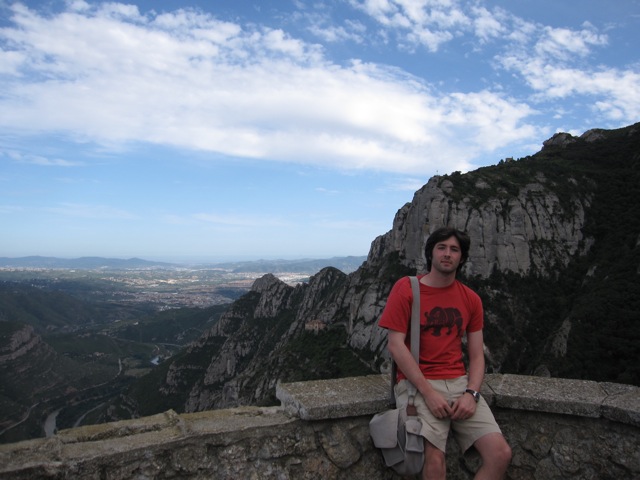
For a change of pace, I thought it would be nice to leave the city. I took a day trip to Montserrat (”Serrated Mountain”). The image of the mountain is very distinctive and well known in Catalonia; you can see it in the distance on the northern side of the city, with massive wind- and rain-worn stones across the top. Catalonians have such affection for it that, apparently, “Montse” is a common name for girls.
It takes about an hour by train to get to the base of the mountain, and then another 30 or so to get to the top. The main feature, once you get there, is a Benedictine monastery, founded in 1025 after a vision of the Virgin Mary. It’s one of the more amazing places I’ve seen; I hope the photos I’m posting do it some justice. The monastery, which has been tended to by monks for centuries, looks like any of the great churches of Europe… except for the fact that it’s perched on the edge of a cliff, thousands of feet above sea-level. You can see Barcelona, the ocean, and even the Pyrenees in the distance. I was there at a quiet time of day, so you could walk around the perimeter of the complex in calming solitude.
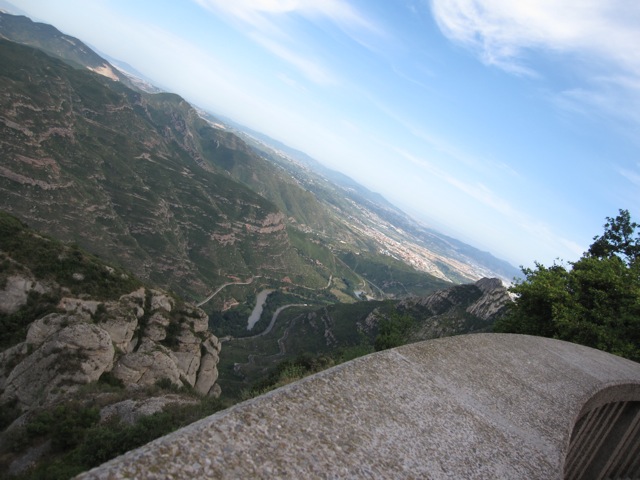
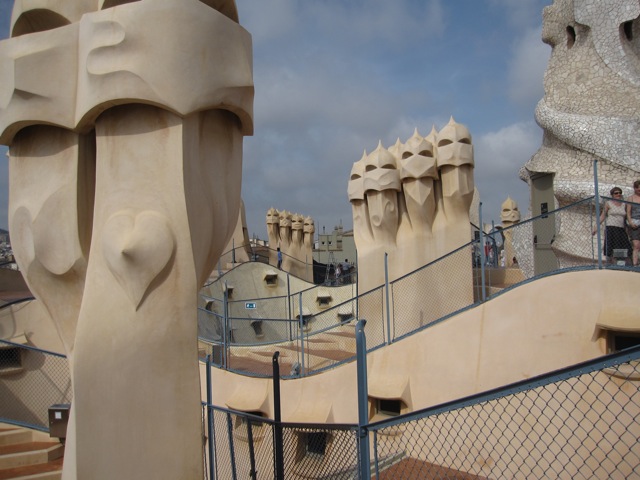
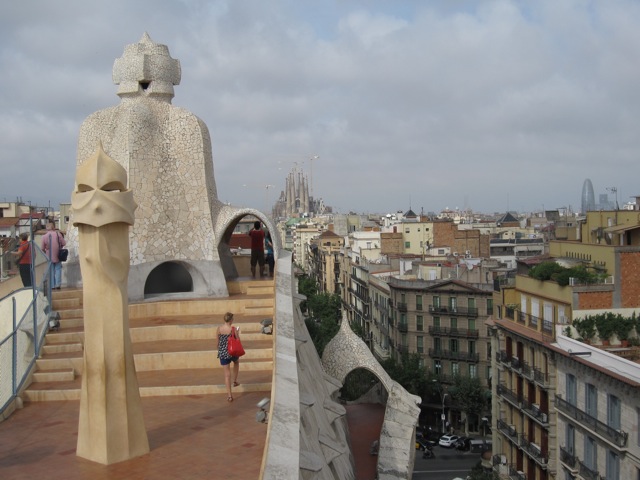

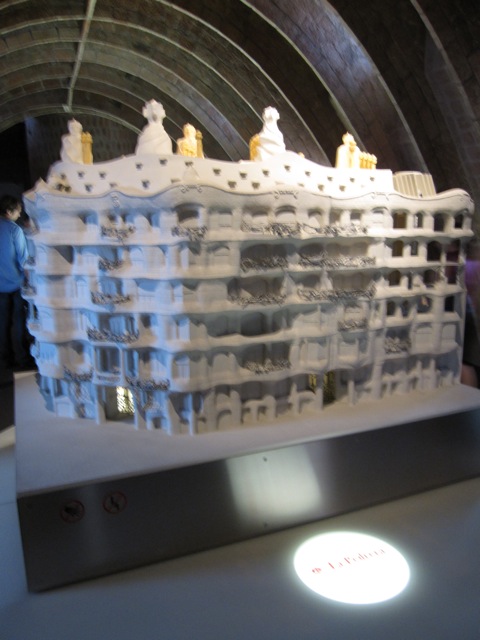
I have to admit, the lack of internet isn’t such a bad thing. Since I’m an internet and e-mail junkie, it’s nice being forcefully cut-off for once.
I’m all settled in my flat, which is in a lovely northern barrio of Barcelona, called Gracía. My neighborhood has many of the same architectural charms of Old Town without the constant flow of tourists. Many of Gracía’s streets, as in Barrio Gotico, are small and winding — but it’s less crowded, and a stroll in any direction turns up beautiful plazas with fountains, statues, and orange trees; no matter the time of day, local residents are socializing over cañas and vino at an endless number of cafés.
My flat is on the fourth floor, and big windows open onto a tiny backstreet, where faint chatter from a popular Catalan restaurant drifts up from three floors below.
My Spanish is certainly rusty, but it’s apparently been enough to occasionally trick people into thinking I’m not a foreigner. At a dinner party this weekend—where conversation was about half in Spanish, half in English—one person said my “American accent’ sounded really authentic… before she realized I was American.
People here ask what I’m doing in Barcelona, and I usually launch into a long-winded explanation of the Pinsky fellowship, about my interest in Spanish poetry and art; but the other day, one of my friends answered for me: “Él es poeta” (he’s a poet). Her succinct answer seemed to work better than mine, so I might stick to that from now on.
Besides unpacking and getting settled, I’ve read a bit of Spanish and English books and practiced the language when I can. In the next few days I’m going to start visiting museums. I was introduced to a Barcelona art promoter, who owns a gallery and promotes local artists; he invited us to some upcoming events, so I’m hoping I’ll get to see the work of younger Spanish artists while also doing the traditional, museum-oriented study of visual art.
When technology allows, I’ll start posting pictures too.
—
I’ve gotten a bit backed up in my blog postings, busy traveling near Barcelona and getting immersed in the sensory overload that is Spain. But I’ll catch up soon.
Otherwise, I’ve been spending a lot of my time reading/writing in cafes, practicing Spanish, exploring the different barrios and parks that Barcelona has to offer, and doing some translating/research for Jose Ángel Valente. He was good friends with a few Catalan artists, like Antoni Tapies, an abstract painter who lived in Barcelona. They have a museum devoted to him here.
I found “A Moveable Feast” — Hemingway’s semi-fictionalized essays on his time as a young, poor writer in Paris — in a second-hand bookshop, and devoured that pretty quickly and enjoyed it (even though, as my fellow traveler Dan pointed out, many of the stories are of dubious factuality). Last week, I stumbled upon a series of small, mostly free, contemporary art museums near my neighborhood. There’s a new 3-floor modern art museum that rotates exhibitions (and is basically free for students). And then there is a small museum for Joan Brossa, the Catalan poet and artist. He’s well known for his “visual poems” which, after seeing them in person, I would say aren’t really “poems”—they’re just works of visual art that occasionally use language. That being said, they’re very playful and enjoyable. Some are mini-sculptures, and others are extended series of art prints.
Here’s one example, that I liked:
 —
—
July 10, 2009

A lucky coincidence. Yesterday I made a trip to the museum devoted to the work of Spanish artist Joan Miró, who was born in Barcelona and spent much of his life here. As I approached the museum, I was surprised to read the posters around the entrance: “Miró-Dupin. Art i poesia.”m
As it turns out, the current exhibition is devoted to Miró’s life-long interest in poetry and literature, with a particular focus on collaborations with French poet Jacques Dupin. Since this topic is part of what I’m here to study, the timing feels quite auspicious. Although I knew Miró’s work, I wasn’t aware of his interest in poetry. Like so many Spanish artists of his generation, Miró spent time in Paris, and while he was there, fell in love with the work of the French symbolist poets, including Apollinaire and Mallermé. Later, he became friends with French poets of his own generation, including Dupin, and his painting and sculpture was influenced by their work.
An excerpt from the exhibit: “In their shared belief that the purpose of art and poetry is not simply representation, they collaborated together on numerous projects during the nearly three decades of their friendship… Joan Miró’s interest in literature can be seen in the books from his private library that are on display along with a selection of paintings, sculptures, drawings and prints from the Foundation’s collections. Parallel to this, a selection of books and poems by Jacques Dupin, illustrated by different contemporary artists, guide us through his world of poetry.”
It’s a fascinating and beautiful exhibit, and I’m looking forward to returning to it again after I have read more of Dupin’s poetry.
—–
TRAVEL ELEGY BY WISŁAWA SZYMBORSKA
To introduce my BU thesis (in an epigraph), I excerpted parts of this poem by the incredible Polish Nobel Laureate, Szymborska; as I’m about to embark on my writing-travel fellowship, it seemed apt to include the poem in its entirety here.
Travel Elegy by Wisława Szymborska
(translated by Stanislaw Baranczak and Clare Cavanagh)
Everything’s mine but just on loan,
nothing for the memory to hold,
though mine as long as I look.
Memories come to mind like excavated statues
that have misplaced their heads.
From the town of Samokov, only rain
and more rain.
Paris from Louvre to fingernail
grows web-eyed by the moment.
Boulevard Saint-Martin: some stairs
leading into a fadeout.
Only a bridge and a half
from Leningrad of the bridges.
Poor Uppsala, reduced to a splinter
of its mighty cathedral.
Sofia’s hapless dancer,
a form without a face.
Then separately, his face without eyes;
separately again, eyes with no pupils,
and, finally, the pupils of a cat.
A Caucasian eagle soars
above a reproduction of a canyon,
the fool’s gold of the sun,
the phony stones.
Everything’s mine but just on loan,
nothing for the memory to hold,
though mine as long as I look.
Inexhaustible, unembraceable,
but particular to the smallest fiber,
grain of sand, drop of water –
landscapes.
I won’t retain one blade of grass
as it’s truly seen.
Salutation and farewell
in a single glance.
For surplus and absence alike,
a single motion of the neck.
—–
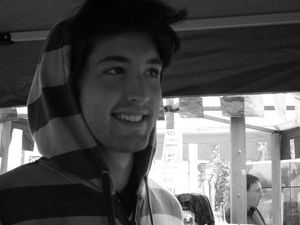
Adam Eaglin
For nine weeks this summer, I will travel to Spain in order to write, translate poetry, and immerse myself in the country’s vibrant arts scene and culture. In January, I began to translate into English the work of the late Spanish poet and essayist, José Ángel Valente. (Hear Valente read ‘El Temblor’.) I was first drawn to Valente’s poetry because of his unique, and very moving, control of language—but I soon became particularly interested in the way Valente was inspired by the artists and painters of his native country.
Based in Barcelona—a city that lives and breathes modern art, from its iconic Gaudí buildings to world-class Picasso and Miró museums—I will travel around Spain to study the visual art that inspired Valente and other poets of his generation. While exploring the Gothic streets of Barcelona’s old town, or studying the paintings of Picasso and Luis Fernández, I also hope to find inspiration for my own poetry.
